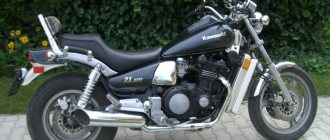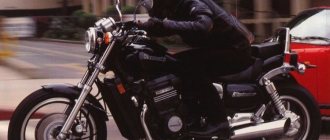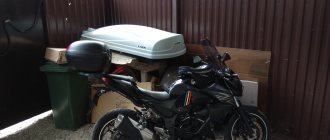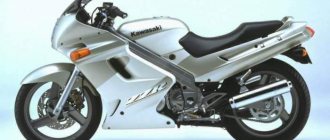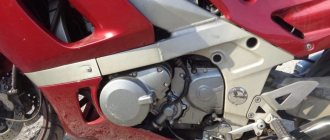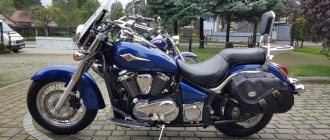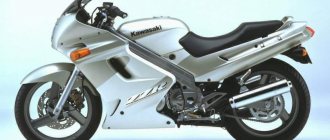- motorcycle model, Kawasaki brand,
The Kawasaki EL250 Eliminator cruiser model was first introduced in 1987 and existed on the market until 2003. Initially, the model was aimed at the domestic Japanese market, but since 1988 it has been available in the USA, and since 1990 - on the European market. In 1996, a version of the Kawasaki EL252 Eliminator was produced for European countries, which had a 252 cc engine. cm instead of the standard 248 cc. cm.
The model was based on an in-line 2-cylinder liquid-cooled engine producing 40 hp. power and almost 24 Nm of torque. Modifications of this engine were also installed on the Kawasaki GPZ250, Kawasaki ZZ-R250 and Kawasaki KLE 250 models. Standard European versions produced up to 33 hp. power.
Other features of the Kawasaki EL250 Eliminator include a steel frame, simple suspension in the form of a conventional telescopic fork and a double shock absorber, front disc and rear drum brakes, a 6-speed gearbox, an 11-liter fuel tank and 134 kg of dry weight.
Main modifications of the Kawasaki EL250 Eliminator:
Kawasaki EL250 Eliminator - regular version.
Kawasaki EL250 Eliminator SH - version is similar to the previous one. Export oriented.
Kawasaki EL250 Eliminator SE - version with semi-fairing and lower plow.
Kawasaki EL250 Eliminator LX is a classic version with spoked wheels.
Kawasaki EL252 Eliminator - version for some European countries. Similar to the previous version, but with a 252 cc engine. cm.
Japanese versions of the Kawasaki EL250 Eliminator were available on the market until 1998, European versions until 2003. By 1998, Kawasaki updated the EL250 Eliminator to the VN250 Eliminator, offering the market a cruiser with more familiar classic shapes and a V-twin engine, finally moving away from the power concept -cruisers of the 80-90s.
Kawasaki ELIMINATOR - a brief history of the series
The Eliminator series appeared in 1985 in the line of the Japanese motorcycle manufacturer Kawasaki. The motorcycles of this series were conceived as “Sport Cruisers”, and therefore sports motorcycles became the donors (in terms of the engine). At one time, the first-born, the EL 900, made a splash and, before the release of the legendary Yamaha V-max, was the most desired motorcycle of Japanese and American bikers. Kawasaki ZL-900 Eliminator (1985-1986) - this model appeared in 1985 and made a splash on the global motorcycle market, as it became the first mass-produced sports cruiser.
Kawasaki ZL-900 Eliminator
The engine came from the GPz900R Ninja model. It was redesigned, and the result was the following: Engine: volume: 908 cm3; cylinders: 4; arrangement: row; power: 105 hp, at 9500 rpm; food: carburetor x4; starting: electric starter; gearbox: 6 speeds; cooling: liquid.
Complaints about the engine include a tendency to overheat (therefore, it is not advisable to show off the bike while standing in one place with the engine running) and also gluttony (you need to look for a gas station every 150 km). Among the features of the motorcycle, we can highlight: rear wheel drive using a cardan, low seating and a correspondingly low center of gravity, as well as very dynamic acceleration. Even now, this concept of a motorcycle (chassis from a cruiser, engine from a sport) is considered something special, let alone in the eighties, experts say that the Kawasaki ZL-900 Eliminator was way ahead of its time! But it didn’t take him long to be the very best, as the Yamaha V-max appeared (the advertising department of the Yamaha company did their job professionally and cleanly, but that’s another story).
Kawasaki ZL-1000
Two years later, the ZL-900 was replaced by the ZL-1000. This model is evolutionary and there are not many stylistic changes (increased fuel tank, modified fenders and seats). But this time, the engine donor was the ZG1000 Concours (in Europe known under the brand name GTR1000 - sport tourist). Engine: volume: 997 cm3; cylinders: 4; arrangement: row; power: 110 hp, at 9000 rpm; food: carburetor x4; starting: electric starter; gearbox: 6 speeds; cooling: liquid.
Kawasaki ZL-1000 Eliminator
This model was produced even less, only one year, but it can still be found on the secondary motorcycle market in Japan.
Kawasaki ZL-750
As an alternative to the “big brothers”, a model with a smaller engine capacity was created - the ZL750. This model was produced from 1986 to 1989.
Kawasaki ZL-750 Eliminator
Kawasaki ZL-600
In 1986, the ZL600 was released. This model was positioned (like the ZL750) as a smaller alternative to its big brothers. The engine donor was the Ninja-600 model. Engine: volume: 592 cm3; cylinders: 4; arrangement: row; power: 74 hp, at 10500 rpm; food: carburetor x4; starting: electric starter; gearbox: 6 speeds; cooling: liquid.
Kawasaki ZL-600 Eliminator
In the press of that time, one could note notes of surprise and joy that, in the theme of “small cruisers,” a motorcycle with a sports bike engine appeared! Agree, now it would look no less cool (a cruiser with an engine from the ZX-6R))).
Kawasaki ZL-500
Little is known about this model. This model has all the features of its brothers, including the appearance and engine concept. Engine: volume: 497 cm3; cylinders: 4; arrangement: row; food: carburetor x4; starting: electric starter; cooling: liquid.
Kawasaki ZL-400
A very popular model on the Russian and Japanese secondary markets. The motorcycle was produced for eight years (1986-1994), during which time several modifications were released (they differed in stylistic changes and minor technical ones - rims, brakes, coloring, drive). On the Internet, you can order many tuning parts for this model. There is a big difference between this model and its older brothers - the drive to the rear wheel is carried out using a chain drive (there are modifications with a belt drive). Engine: volume: 398 cm3; cylinders: 2; arrangement: row; power: 54 hp, at 12000 rpm; food: carburetor x2; starting: electric starter; cooling: liquid.
Kawasaki ZL-400 Eliminator
The cost of this motorcycle model on the secondary market is ~ 80,000-100,000 rubles.
Kawasaki EL-250
Model EL250 was released in 1987. The engine came from the GPX-R 250. As in the 400, instead of a cardan, a chain drive was used on the rear wheel. Engine: volume: 398 cm3; cylinders: 2; arrangement: row; power: 35 hp, at 9500 rpm; food: carburetor x2; starting: electric starter; cooling: liquid.
( added : The Kawasaki Eliminator 250V model has a V-engine with a cylinder angle of 90 degrees, 4 valve heads, 38 horses and a maximum of 12500 rpm, produced from 1998 to the present in Japan, but export is complicated, because because for 250 cubic meters they don’t issue PTS)
Kawasaki EL-250 Eliminator
Kawasaki EL-125
The only model from the Eliminator family that remains in the Kawasaki program is the EL125. This bike is positioned as an entry-level motorcycle. According to European legislation (I don’t know for sure about American legislation), drivers with category B have the right to ride motorcycles with an engine capacity of up to 125 cm3, so thrifty Europeans readily take them. An engine with no pretensions to sport,... just an engine))
Kawasaki EL-125 Eliminator
Conclusion: This family of motorcycles has been in production for a very long time, and clubs for Eliminator connoisseurs can now be found all over the world. In Russia they were also very popular because of their ease of maintenance and low price, especially the ZL400 model. Unfortunately, at one time, these motorcycles were not featured in any big-budget film (unlike the V-MAX), which is a big omission of the Kawasaki PR people. More recently, Yamaha Corporation updated its bestseller – V-MAX, and who knows, maybe the specialists from Kawasaki will remember the legendary ELIMINATOR line.
Model history
1987 - start of production and sales of the Kawasaki EL250 Eliminator model. Model: Kawasaki EL250 Eliminator (Japan). Factory designation: EL250-B1.
1988 - appearance of the SE modification. The model is officially sold in the USA. Model: Kawasaki EL250 Eliminator / SE (Japan, USA). Factory designation: EL250-B2, EL250-A2 (SE).
1989 - appearance of the LX modification. Model: Kawasaki EL250 Eliminator / SE / LX (Japan, USA). Factory designation: EL250-B3, EL250-A3 (SE), EL250-C1 (LX).
1990 - model sold in Europe. The regular version is no longer offered in Japan. Model: Kawasaki EL250 Eliminator SE/LX (Japan, Europe). Factory designation: EL250-A4 (SE), EL250-C2 (LX).
1991 - Japanese versions are no longer produced. Model: Kawasaki EL250 Eliminator SH (USA, Europe). Factory designation: EL250-E1.
1992 - no significant changes. Model: Kawasaki EL250 Eliminator SH (USA, Europe). Factory designation: EL250-E2.
1993 - resumption of production in Japan. The model is also sold in Canada. Model: Kawasaki EL250 Eliminator SH/LX (North America, Europe, Japan). Factory designation: EL250-C3 (LX), EL250-E3 (SH).
1994 - no significant changes. Model: Kawasaki EL250 Eliminator SE/SH/LX (North America, Europe, Japan). Factory designation: EL250-A5 (SE), EL250-C4 (LX), EL250-E4 (SH).
1995 - model not produced. 1996 - the appearance of a new European version of the EL252 Eliminator. Model: Kawasaki EL250 Eliminator SE/LX/252 (North America, Europe, Japan). Factory designation: EL250-A6 (SE), EL250-C6 (LX), EL250-F2 (252), EL250-D7.
1997 - Only a new European version of the EL252 Eliminator is produced. Model: Kawasaki EL252 Eliminator (Europe). Factory designation: EL250-F3.
1998 is the last year of production of the Japanese version of the EL250LX Eliminator. This year's models feature a silver color. It is being replaced by a completely new model - the Kawasaki VN250 Eliminator. Model: Kawasaki EL250 Eliminator LX (Japan). Factory designation: EL250-C8.
1999 - Only the European version of the EL252 Eliminator is produced. Model: Kawasaki EL252 Eliminator (Europe). Factory designation: EL250-F4.
2000 - model not produced. 2001 - no significant changes. Model: Kawasaki EL252 Eliminator (Europe). Factory designation: EL250-F5.
2002 - model not produced. 2003 is the final year of production of the Kawasaki EL252 Eliminator. Model: Kawasaki EL252 Eliminator (Europe). Factory designation: EL250-F6.
Characteristics:
| Model | Kawasaki EL250 Eliminator |
| Motorcycle type | cruiser |
| Year of manufacture/sales | 1987-1998 (2003) |
| engine's type | 2-cylinder, 4-stroke, in-line |
| Working volume | 248 cc cm 252 cc see - EL252 Eliminator (Europe) |
| Cooling | liquid |
| Bore/Stroke | 62.0 x 41.2 mm 62.5 x 41.2 mm — — EL252 Eliminator (Europe) |
| Compression ratio | 12.0:1-12.4:1 (depending on version) |
| Number of valves per cylinder | 4 valves per cylinder (DOHC) |
| Fuel supply system | carburetor, x2 Keihin CVK30 |
| Ignition type | fully transistorized |
| Maximum power | 40 hp (29.4 kW) at 12500 rpm 33 hp. (24.1 kW) at 12500 rpm - European versions |
| Maximum torque | 23.5 Nm at 10,000 rpm 20.0 Nm at 10,000 rpm - European versions |
| Transmission | 6-speed |
| type of drive | chain |
| Frame | steel tubular |
| Front suspension | telescopic fork 36 mm, travel - 140 mm |
| Rear suspension | pendulum with two shock absorbers, stroke - 100 mm |
| Front tire size | 100/90-17 55S |
| Rear tire size | 140/90-15 70S |
| Front brakes | 1 disc 260 mm, 1-piston caliper |
| Rear brakes | drum, 160 mm |
| Dimensions (L x W x H) | 2140 x 745 x 1110 mm - SE 2140 x 665 x 1045 mm - LX |
| Seat height | 700 mm - SE 725 mm - LX |
| Wheelbase | 1490 mm |
| Gas tank capacity | 11.0 l |
| Maximum speed | 155 km/h - Japanese versions 139 km/h - European versions |
| Acceleration to 100 km/h | 7.0 sec - Japanese versions 8.2 sec - European versions |
| Motorcycle weight (dry) | 134 kg - regular version 142 kg - LX 143 kg - SE |
| Motorcycle weight (curb) | 152 kg - regular version 158 kg - LX 159 kg - SE |
Review of the Kawasaki EL 250 Eliminator motorcycle
The motorcycle is quite old (1988), but after 2 seasons, I can say that it will live for a very long time, because during the entire time I owned it I had no problems, I bought it second-hand and very spontaneously, the budget was around 70 000, of course, like all beginners, I looked at bandits and seabirds, but they were very expensive and an eliminator turned up for me, I went with a friend to look, we arrived, it was clear that the motorcycle was well-maintained, there were shoals on the tank in the form of scratches and dents, but they I wasn’t too worried, it started right away, I was happy about it, it worked quietly and smoothly, I walked around and looked, well, I think I’ll go for a ride, I sit down, the seating position is very comfortable, since the motorcycle is low and the handlebars with the stem are very conveniently located in front of you, I start to move off, I let go a little clutch and... off I went, I was very surprised that getting started on this motorcycle is easier than on a bicycle, I rode a little, I was pleased with the soft suspension and the smooth ride of the motorcycle, I went home, so to speak, to think, the next time I bought it) First trip, I'm getting underway also elementary, I get out on the road and start accelerating, the acceleration for a 250 cc in-line 2-cylinder engine is very good, there are no obvious failures, starting from 2 thousand the engine turns decently until the 13 thousand mark, the brakes are good, especially the front disc, acceleration from a standstill better than classmates such as the bandit, but on the highway after 120 km it loses in dynamics, the sound is quiet, the landing is comfortable, in general I was in seventh heaven, later I went with friends on a mini-long trip)) from Krasnodar to Goryachy Klyuch, to I rode confidently on the highway, the motorcycle did not show any flaws, we rode successfully there and back, around the city, probably one of the most comfortable motorcycles, small, nimble, with excellent handling and low fuel consumption. To sum up, I can say that the motorcycle, despite for its age, it has never let me down, it is very comfortable and has a good, unpretentious engine that allows you to start from traffic lights on par with some 400s. I would recommend it as a first motorcycle to all beginners. Thank you for your attention, good luck on the roads, buy elims))
The motor is very light in weight and is therefore highly susceptible to shifting by the wind.
The rear shocks need to be adjusted to suit the specific driver due to the fact that when the springs are retightened, they begin to wobble very strongly on the longitudinal cracks.
in small radius turns it bends towards the inside of the turn.
insufficient braking dynamics when using only the front brake. at low speeds (up to 60 km/h) it is quite enough, but then you have to use the rear very sharp drum to reduce the braking distance.
during active driving there is a very immodest appetite for 95th gasoline (up to 8 liters per 100 km).
It is very inconvenient to maintain the chain due to the lack of a central stand.
In sunny weather, the indicator lights are difficult to read (my copy does not have a bikini fairing).
possible lack of downshifts. The box is loud and clear.
to replace spark plugs you have to remove the tank and ignition coils... you need a spark plug of medium length (mine is 12cm) with thin walls.
carbs are subject to frequent desynchronization (why).
when replacing the fork seals, I swore for a long time due to the fact that the plugs of the stays are installed on locking springs, which even with the help of a friend could not be removed, as a result, it was not possible to wash the guts of the front shock absorbers... when unscrewing the retaining bolts
you have to be careful and use untortured hexagons as the bolts are susceptible to the splines breaking off. Oil filling was done through the oil drain holes. When filling engine oil with a viscosity of SAE 20, the dive when braking decreased noticeably.
When changing engine oil, it would be good to use flushing fluid and not a 5-minute additive, since due to the design of the oil pan, a fairly decent amount of old oil remains, 100-150g out of 1.9 liters provided when filling with an oil filter change. It is advisable to remember that the moto is on its side and not to pour immediately to the maximum level, otherwise it will overflow (I forgot and then had to drain it).
but all shortcomings are compensated by serious acceleration in all 6 gears. cruising speed 120 km/h I managed to push mine to 160 maximum speed ((: drive in control in dynamic shots from traffic light to traffic light and unsharp maneuvering in traffic..
I’ve been driving the EL 250 for three years now, and I want to share my impressions. Rear brake - full. It either doesn’t slow down or immediately blocks; I use it very rarely. The front one is of course better, but still rather weak, but it can be helped by the engine - when I release the throttle, the bike itself slows down quite intensively. When braking sharply, there is a dive, but I'm already used to it. About the fork seals: when I bought the bike from the previous owner, he told me that he did not buy original ones, but picked up seals from Toyota that were similar in diameter at an auto parts store. They turned out to be a little larger, so he somehow expanded the seat and stuck them there. Toyota ones are much cheaper, and they are easier to get, at least in Novosibirsk. In three years of operation I have never changed them, there was no need. There are no complaints about the rear shock absorbers. The box works clearly, both up and down, the only drawback is that it is very loud. Replacing the air filter and spark plugs caused problems only the first time, then I easily remembered the algorithm for removing the seat and tank. The engine, despite its modest size, is quite strong enough to be the first to leave a traffic light. Comfortable speed is 100 - 120. The maximum speed was 140 km/h, at 11,500. The red zone on the tachometer starts at 14,000, so there is still some reserve. I just don’t want to go faster. It blows away!!! And yet he’s light, he’s trying to fly, damn it! This is where some of our smaller brothers (motorists) overtake! It's a shame! I never measured my consumption, but if I ate a lot I would have noticed. Although the fuel level would not be a problem, sometimes you forget and go far, and on the way back you think - will it be enough or not? The oil level has not dropped a millimeter over the season. Regarding the instruments: there are no complaints about the speedometer and tachometer, but the indicator lights are not visible in sunny weather. But at night everything looks very beautiful, because... The backlight is like on a BMW, red. I have a straight steering wheel, there are no problems with turning on the spot and when maneuvering in motion, everything is very comfortable, my arms and back do not get tired even if I have to drive very far. Of course, there is a tendency towards blockages, but if you keep the situation under control, then everything will be ok. Another positive point is the direct flow inherited from the old owner. The twin sounds especially beautiful at low end. But for some reason the neighbors don't like it. This season I bought plastic luggage cases. For a long time I doubted whether to install them or not, but when I did, all doubts immediately disappeared. This added solidity to the motorcycle, it is now just like an adult. Yes, I also really don’t like this aspect: the front fender is a bit short and therefore half of the radiator is always clogged with dirt. There have never been any overheats, but constantly cleaning the radiator is annoying. In general, the motorcycle is incendiary!!!
I rode for two years, it was my first “Japanese bike”, I’m very pleased, the steering wheel is easy and the speeds are switched “clearly”, in the city - good dynamics, though 6 speeds - you constantly click, but the 6th is quite high-torque and pulls out from 50, consumption - 3-4 liters . In the city it’s comfortable, light and narrow, above 110 it’s really uncomfortable..
About the brakes - I changed the pads and repair kit (rubber bands and polished the brake cylinders) on the front, I just rebuilt the rear - it brakes very well, softly and tenaciously.
About the tidy... the lamps are invisible in sunny weather, I changed them to LEDs and it became much better.
I can only leave positive feedback. The pepelats was bought from a Japanese trash heap, apparently it was at the bottom of the heap since the shock absorbers were folded and rusted in this position, compressing the springs. The rear shock absorbers were with expansion chambers, cut, knocked out, and the rods were sharpened from the gas lifts of the Laurel hood. the front fork sagged, after screwing in the nipples and 1-1.5 kg, just a song. It was all bolted down and painted with varnish. I installed a car alarm, horns, compressor, and receiver. I ran through everything quickly. I accelerated to 180 as much as possible, although the wind was tailwind and lay behind the visor. An excellent motorcycle for those who like to drive hard. It’s fast enough to accelerate to hundreds, but after 140 it’s already a bit difficult, and with a passenger it’s much earlier. consumption is 6-8, but if you wish you can go to 10. doesn't eat butter. I’m now collecting dust in the garage for the second season, maybe I’ll sell it, but I don’t know for how much….
I acquired this motor shortly before the end of the season. I chose for a long time (due to the lack of coins), I didn’t look at anything (initially there was a criterion: no less than 400), I looked at a cactus for 50 k, well, it was in a very tired state (the tank is rusty, the plastic in the bikini area is on snot and wire, the carbs were not reset below 4000 rpm. Well, I completely gave up. After the technician, the next day I stopped by Industrialnaya to do nonsense, look at the spendthrifts, wandering through the rows of Oleg’s, I thought: To hell with scabies, chick also rolled, climbed into the core, I see Elim costs 250 se. Well, after consulting with my friend Palladin - the noble Elimovod, I called the seller, agreeing on a viewing for the evening. We met at Komsa, examined the Elim (after the sensations about the cactus, I was very pleased, mot was polished, without any defects on the exterior, the tires were in excellent condition. Well, I took it for a ride. The motor showed its best side: good dynamics, comfortable fit (my height: 187 cm), pleasant twin sound (especially at the bottom) and in general I was satisfied. Returning to the seller, I agreed to purchase. The next day: re-registration, registration and the way home, wash)). In general, I managed to drive it before the wild frosts and snow: 1700 km. Yes, this is not a sufficient mileage, but even after the car got used to the acceleration and 155 km/h was no longer enough, I don’t regret the purchase at all. (speed is not happiness). In general: Cool lighter) but the check is modest, but if you need a moto to quench motor toxicosis or leisurely rides around the neighborhood or city, then this option is really good)
My first motorcycle. When I was planning to start, I didn’t have any particular preferences - I was looking for something I liked for the money I had (70 rubles). When I came across it, I fell in love from the first photo. Looks just awesome :). The motorcycle is very light - only 140 kg. Markings on the speedometer up to 160 km/h. I personally accelerated to 140 with a passenger. An excellent option for beginners, as it is light weight and easy to operate. It pulls two people, but you can already feel the passenger, especially if you’re not carrying a girl. Also, when driving with two people, the rear suspension breaks. The brakes are excellent: very grippy and predictable. A couple of times, out of fright, I skidded off the rear wheel, but everything worked out :) The motorcycle also has pretty decent dynamics at speeds of up to 100 km/h, although I haven’t measured the acceleration yet, but I’m not far behind my friend on a Yamaha Virago 1100. This also makes it difficult to drive calmly at times :).
Consumption per hundred from 3.5 liters. On the highway, with quiet driving at 100 km/h. That's how it works. In the city, especially if you burn it out, consumption can easily reach 10 liters, which, with a small tank (13 liters), is a frequent reason for visits to gas stations :)
Due to the unique design of the exhaust, it is difficult to maintain. If you get into the carburetors or engine, it must be removed.
I really like the motorcycle, I plan to finish this season. In the future, I wouldn’t mind staying at the older lums. 
